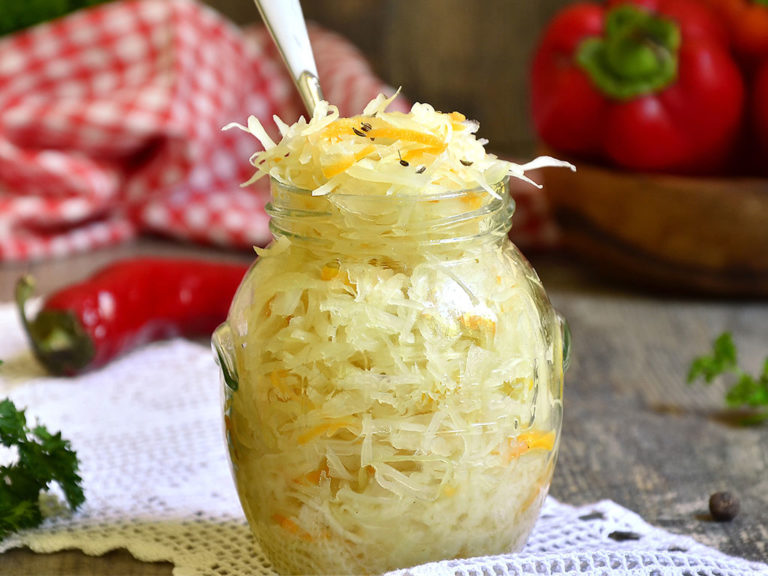Did you know sauerkraut heals? Pretty much everyone craves salt. Pickles and foods fermented with salt (and sometimes vinegar) are universal. Every cuisine has its own treasured recipes. There’s a lot more to salt love than the pleasant tang on your tongue, however.
Humans crave salt because we need it to be healthy. The average human body has about 40 teaspoons of salt which are continuously lost in sweat and tears. That’s why we must add some salt into our system every day. I add salt to my diet with a teaspoon of sole, and I also eat some fermented foods every day.
What is Fermentation
Fermentation is the process by which beer, wine, vinegar is made, and is also one of the oldest forms of food preservation. Fermenting vegetables is still healthier than canning and freezing vegetables and fruit. Fermenting occurs with just salt, or just sugar. Pickling occurs when vinegar is added. You can ferment with vinegar as well as salt.
Funky Ferments
Something magical (or rather biological) happens when salt is added to vegetables with enough water to cover, is hermetically sealed, and the left out for a few days or weeks. Lacto fermentation occurs. The result of fermentation gives us the probiotics we need for healthy digestion and many other benefits. There is new interest in fermentation because fermented foods lower acid in the stomach and promote healthy digestion. Think of probiotics as natural antacids. You can get your daily probiotics from yogurt or kefir, which are a fermented dairy foods, as well as sauerkraut, kimchi, kombucha, or any fermented vegetables.
Check Out My New Book, The Mother Daughter Relationship Makeover
Cabbage Is the Starter Ferment For Foodies
Most health food fans begin their fermenting experiments with cabbage. Cabbage is one of the healthiest foods you can eat. And fermented cabbage is even better. Rich in vitamins C, B and K, sauerkraut is even more nutritious because the fermentation process increases bioavailability. Sauerkraut is a good source of several minerals, including calcium and magnesium. It also has some antioxidant properties, such as lutein and zeaxanthin, which are associated with maintaining good eye health.
The juice from sauerkraut is a concentrated source of nutrients that has been used for medicinal purposes. Vitamin U was named by Dr. Garrett Cheney, who found that cabbage juice worked wonders with the treatment of peptic ulcers. In Finland, researchers found that one property of sauerkraut inhibits the growth of cancer cells in test tube and animal studies.
In a 2010 Polish researchers concluded that “… induction of the key detoxifying enzymes by cabbage juices, particularly sauerkraut, may be responsible for their chemopreventive activity demonstrated by epidemiological studies and in animal models.” In other words, it’s a cancer preventative. Sauerkraut juice is included in the Budwig preventative and curative anti-cancer diet. Try it, you’ll like it.
Sauerkraut History
Sauerkraut did not originate in Germany, but rather dates back six thousand years to China where it was served as a staple food for those building the Great Wall. Captain Cook’s sailors were fed sauerkraut on all their voyages as an antidote for scurvy. Now we know that the live action of lactic bacteria (which causes fermentation) facilitates the synthesis of vitamin C. Sauerkraut is an extremely healthy food. And yes, Germans have such a passion for it their nickname has been kraut since about the 16th century.
I eat some form of fermented cabbage every day, and I feel the difference when I don’t.
Ingredients
- 1 Cabbage
- (you can also add red cabbage, carrots, and other veggies, but start with the plain cabbage first)
- 2 to 3 Tablespoons of Himalayan Pink Salt. (I use 2 1/2 TBSP. Be careful about using too much or your sauerkraut will be too salty)
- Glass jars or crock
- Stones or weights
Directions
- Slice cabbage thin (reserving the outside leaves)
- Mix in a big bowl with the pink salt
- Toss well, leave for several hours or overnight
- Some people just leave the salt and cabbage overnight and don’t bother to pound it. But the traditional way is to pound more moisture out.
- Add extra flavors like one of the following: caraway seeds, or sliced ginger, or mustard seeds, or a chili pepper. (Warning, only a little is needed to provide an intense flavor)
Now To Ferment
Tightly pack cabbage in glass jars or a pickling crock.
Press the cabbage down as hard as you can to get all the air out, and to bring the moisture to the top. Cover the cabbage with the reserved outside leaves, and tuck around the edges. If there is not enough liquid to cover the cabbage leaf, add more brine, but leave enough room for cabbage to swell and air to get out. Then put the weights over the cabbage leaves to make sure the salted water covers everything and no air can get in. River rocks will do. Cover with a jar lid or crock lid.
Brine is made by adding 1TBS Pink Salt to 1 quart of water (some people say 2 TBS, but I think that’s too much). Dissolve salt in water and add to crock as needed.
Leave out in a cool place for at least seven days if you’re making a small batch or for 2 weeks if you’re making a large batch in a big crock. Open the lid, once or twice to get the air out, and remove foam if there is any.
When the fermenting period is over, remove the weights and cabbage leaves. Repack the large batch of sauerkraut in smaller glass jars and store in the refrigerator for up to a year.
Every batch is going to taste a little different. Your sauerkraut will always be tangy, but it should also be crisp and not too salty and other seasonings should not overpower it. Just experiment and don’t worry if the first batch is not everything you hoped it would be. Practice makes perfect.
30 Days Sober Has This Affect On Your Body
22 Tips For Sober Life This Summer





















